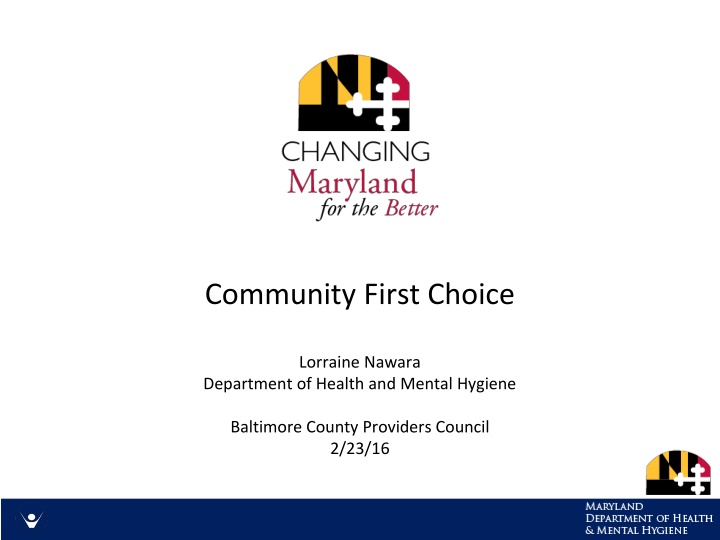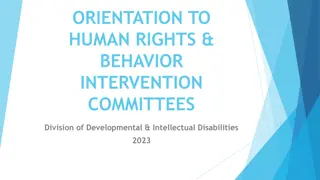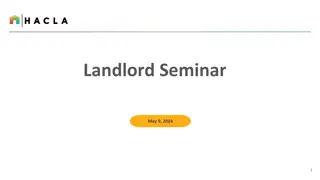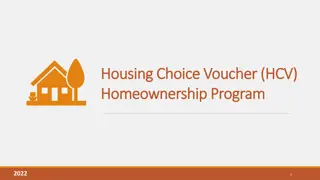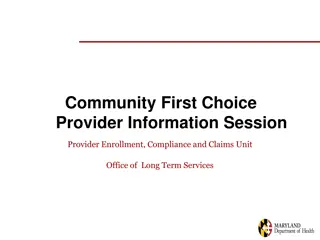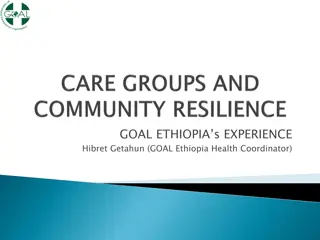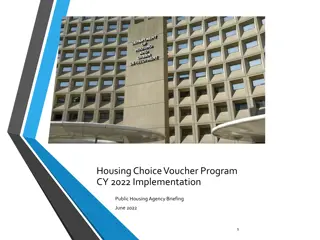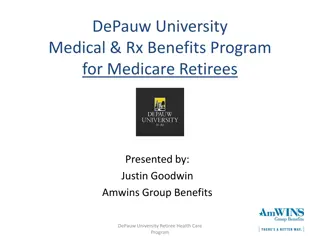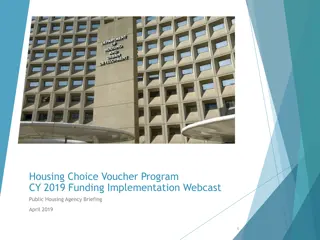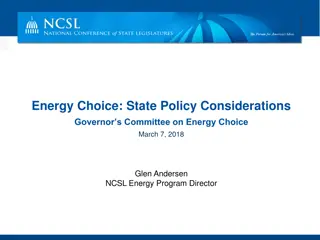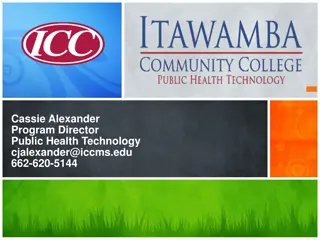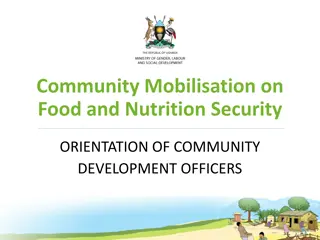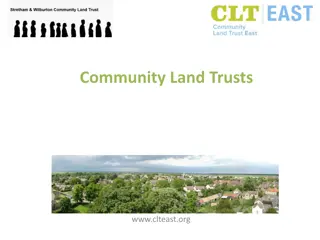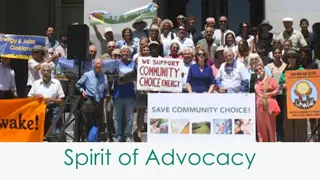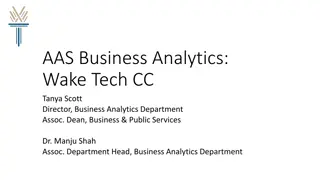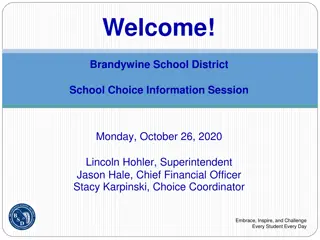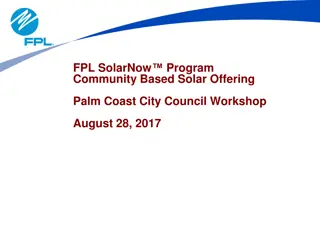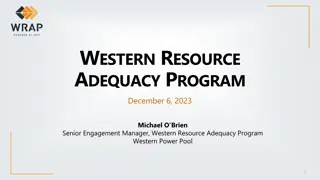Community First Choice Program Overview
The Community First Choice (CFC) program, part of the Affordable Care Act, expands options for community-based long-term services and supports for individuals eligible for Medicaid. It eliminates waiting lists, enhances matching funds, and promotes consistent policies across programs. The program also has specific financial, medical, and technical requirements, and offers a new service structure that consolidates various programs under CFC. Additionally, the Medical Assistance Personal Care program has been restructured as Community Personal Assistance Services.
Download Presentation

Please find below an Image/Link to download the presentation.
The content on the website is provided AS IS for your information and personal use only. It may not be sold, licensed, or shared on other websites without obtaining consent from the author.If you encounter any issues during the download, it is possible that the publisher has removed the file from their server.
You are allowed to download the files provided on this website for personal or commercial use, subject to the condition that they are used lawfully. All files are the property of their respective owners.
The content on the website is provided AS IS for your information and personal use only. It may not be sold, licensed, or shared on other websites without obtaining consent from the author.
E N D
Presentation Transcript
Community First Choice Lorraine Nawara Department of Health and Mental Hygiene Baltimore County Providers Council 2/23/16
Topics Community First Choice Overview Agency-only model Waiver Registry Screening and triaging the registry Community Settings Rule Planned Initiatives
Community First Choice (CFC) Affordable Care Act (ACA) program expanding options for community-based long-term services and supports Allows waiver-like services to be provided in the State Plan Expands access to people who are eligible for Medicaid in the community No waiting list Increases the State s enhanced match on all CFC services by 6 % Allows Medicaid to set consistent policy and rates across programs 3
Community First Choice Financial Requirements Community MA Eligible Must already be in a waiver OR eligible for Medicaid in the community Medical Requirements Institutional level of care Includes nursing facility, chronic hospitals, ICF/IID, and psychiatric hospitals Technical Requirements No age restrictions Participants must reside in a community residence as defined by the new HCBS settings rule
New Service Structure Services formerly offered through multiple programs are now consolidated under CFC Maximizes the enhanced Federal match Resolves inconsistent rates and policies across programs Two 1915(c) waiver programs merged into a single waiver Living at Home and Waiver for Older Adults are now merged into the Home and Community Based Options Waiver Medical Assistance Personal Care program was revised to mirror CFC 5
MAPC to CPAS The Medical Assistance Personal Care (MAPC) program is now called the Community Personal Assistance Services (CPAS)program No longer managed by the local health department (LHD) Services are no longer per diem, but follow the waiver/CFC structure of 15-minute units and billing through ISAS Uses the same supports planning network Subject to nurse monitoring for quality oversight by the LHDs Program fully converted on 10/1/16
Former Service Structure MAPC LAH WOA Personal Assistance Services Case Management/Nurse Case Monitoring Consumer Training Personal Emergency Back-up Systems Transition Services Home Delivered Meals Assistive Technology Accessibility Adaptations Environmental Assessments Medical Day Care Nutritionist/Dietician Family Training Behavioral Consultation Assisted Living Senior Center Plus 7
Current Service Structure CPAS CFC Waiver Personal Assistance Services Case Management/Supports Planning Nurse Monitoring Personal Emergency Back-up Systems Transition Services Consumer Training Home Delivered Meals Assistive Technology Accessibility Adaptations Environmental Assessments Medical Day Care Nutritionist/Dietician Family Training Behavioral Consultation Assisted Living Senior Center Plus * * * * * * * * * * *CFC Services are available to waiver participants
Program Enrollment 10/23/2015 11/16/2015 12/9/2015 2/12/2016 CFC Only 5,047 5,163 5,207 5,527 CO 4,043 4,026 4,025 3,972 ICS 19 22 21 21 CPAS 340 354 367 389 Total Program Participation 9,499 9,565 9,620 9,909 Of the CO participants Living in ALF 1,189 1,195 1,198 1,192 Community 2,854 2,831 2,827 2,780 Total CFC Participation (CFC Only + CO Community) 7,901 7,994 8,034 8,307
Accessing Services Applicants can begin the CFC process by calling their local Maryland Access Point (MAP) site Statewide 1-844-MAP-LINK (1-844-627-5465) Baltimore County MAP 410-887-2594 https://md.getcare.com/consumer
Agency-only Model and Self Direction Federal Department of Labor issued a rule that extended the Fair Labor Standards Act protections to personal assistance workers Also issued guidance indicating that state Medicaid programs were joint employers in most self-directed programs This change would have required Medicaid to pay travel and overtime to independent personal assistance providers Maryland s programs converted to an agency-only model on October 1, 2015 in order to comply with the new rule and manage costs of the program DHMH is currently working towards a new self-direction program with the participant as the sole employer
Waiver Registry Updates Waiver for Older Adults and Living at Home waiver registries were merged with the creation of the Home and Community Based Options waiver Currently over 30,000 people on the registry Registrants have not been screened for eligibility, is an interest list Anyone on the registry who has community Medicaid can apply for CFC or CPAS services now Only those who do not meet the community MA financial standard or who want assisted living services need to wait for a waiver slot Currently sending out about 50 applications per month on a date order basis
Screening the Registry MAP sites are using a screening tool to help identify the needs of people in need of services Offered prior to placement on the waiver registry Screening of those already on the registry will begin in April 2016 Hilltop Institute is analyzing data from the screening tool to refine algorithm for institutional risk Will be used to prioritize the registry in the future
Community Settings Rule Home and Community- Based Setting Rule was issued by CMS and became effective on March 17, 2014 Redefines community as a set of characteristics instead of a bed-size or service type Intent of the Community Rule Ensure individuals have full access to the benefits of community living Enhance the quality and provide protections to participants
Whos Affected? Participants and providers of: Medical Day Care Senior Center Plus Therapeutic Integration Assisted Living Residential Habilitation All settings must in be in full compliance by March of 2019 in order to continue to receive federal Medicaid funding
Principles of the Rule Integration Proximity to community amenities Availability of transportation Interaction with the wider community Not within or near an institution Individual Rights Same life as people without a disability Right to locked bedroom and bathroom doors Tenant Rights/Residential Agreement Autonomy Choice of roommates Freedom to decorate living space Receive visitors at all times Access to food at all times Physical access to public spaces
Provider-Owned or Controlled Residential Settings Setting is physically accessible to the individual Individuals may have visitors at any time Homes have lockable entrance doors, with the individual and appropriate staff having keys to the doors as needed Each individual has privacy in their own room Individuals sharing rooms have the choice of their roommate They control their schedules and have access to food any time
2016-2018 Initiatives New Self-direction option Request for Proposals for a fiscal management vendor Implement the community settings rule Provider self-assessment Participant surveys Site visits/provider re-enrollment Rate study Triage the registry Quality incentive payments ICS Expansion Improved quality reporting, trending, and program evaluation
Questions? Lorraine Nawara Deputy Director for Community Integration Long-Term Services and Supports Administration Lorraine.nawara@maryland.gov
